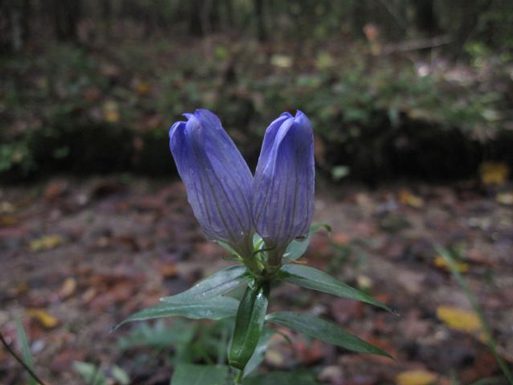Gentian abloom in our woodlands

Although a hard word to pronounce, “gentian” is a group of pretty flowers that are found all over the world, on all continents except Antarctica. There are more than 1,000 species of gentian worldwide, and gentians are found in a wide variety of habitats, from rainforest to desert. In this area, gentians are typically found in woodland boggy stream habitats. They are believed to be named after an early king of Illyria (part of what is now Croatia) named Gentius, who was believed to have discovered their herbal properties.
Certain gentian species have historically been used by humans as herbs and for tonics, as they have a bitter taste. They’ve been used for everything from aiding in digestion to weight loss. Some gentians are still harvested for flavoring liqueurs and beer, and are used in some countries as a medicinal remedy for malaria and snake bites.
North of the equator the gentian bloom usually has a blue to purple, but red-flowered gentians dominate the Andes of South America. Gentians with white flowers occur in patches throughout the range, but are specifically found in New Zealand. Gentian flowers have a diverse group of pollinators including moths, bees, birds, bats and flies.
One gentian I’ve seen in North Carolina is often called bottle or closed gentian. It is an interesting flower in that it never truly blooms or opens, but instead looks like it is a bud. Stumbling upon it in the woods, I wondered how it was pollinated. It seems counterintuitive to produce a showy flower but not open it to get pollinated. However, it is thought that these flowers are pollinated exclusively by large bumblebees with the strength needed to force them open. This is thought to be a form of symbiosis called mutualism: The bumblebees are specialized to this flower and have almost exclusive rights to the pollen and nectar, and the flower is pollinated by a species known to effectively pollinate them, increasing the species’ chance of survival.
On the other extreme, a very showy species of gentian is found in the Sandhills, called Pine barrens gentian (Gentiana autumnalis). (For more information, and to see photos, click here.) It’s one of the imperiled types of gentian. Many of the gentian species need a specific type of habitat and require careful management to exist.
The gentians are beginning to bloom in this area, so keep your eye out for their brilliant blue hues in forest habitats. They are difficult to cultivate, so to continue to enjoy their beauty, we must keep their habitats intact.
To learn more about gentians click here (Rutgers research site).
Photograph by Crystal Cockman